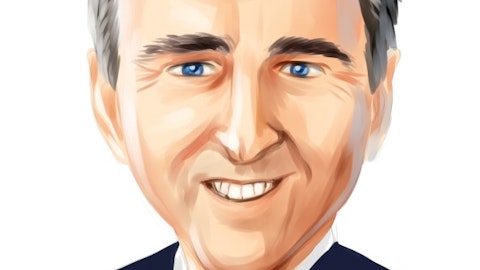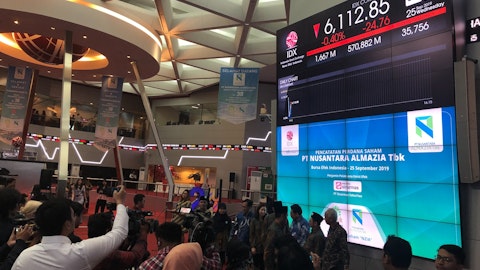We’re beginning to see rogue behavior by some vendors in the space who are keen to retain their customers, primarily in the legacy vendor space and the start-up space. We intend to combat that with investing in this space and trying to accelerate platformization and consolidation for our customers. We’re also seeing increased demand for AI, along with deploying AI in our products or big needs to our customers asking us to help them protect for a successful and responsible deployment of AI in their infrastructure. Putting this all together, these trends of the market bolster our conviction that adopting platforms is the only viable strategy for customers and leveraging AI is imperative. We want to march faster to our aspiration to become the sales force, to become the service now, or the workday of cybersecurity.
Customers have adopted platforms in other markets across technology, and this will inevitably happen in cybersecurity. These industry trends set up conditions that favor leaders that can drive consolidation. We intend to answer this challenge. With all the problems that platformization holds, adoption is not always easy for many of our customers. Until now, we have primarily assumed that our customers adopt our platforms at their own pace. The crux of the challenge is around execution. Customers face risk in executing or making significant changes to the environments as well as economic exposure from these changes. Key friction points you’ve noticed include the challenge of replacing multiple products simultaneously as well as the issues around double playing while working through complex contract terms.
Over the last six months, we have been quietly working to develop programs that enable us to help minimize and even share in the risk of our customers’ face. You will see us tomorrow launching a significant number of platform offers to our customers to help drive the consolidation and platformization strategy. We believe we can build customer confidence in our platforms by approaching them well before their point product contracts expire. After we gain their contractual commitment, we have offered an extended rollout period where we can demonstrate our ability to deliver these platform benefits. Customers can then start paying us after the obligation of legacy vendors ends. With the experience we’ve gained over the last six months, we believe now is the right time to accelerate programs across our portfolio to drive this platformization.
All these programs will have mechanisms to reduce customer friction, accelerate product deployment, help customer realize the value of our platforms, and consume new innovation sooner. While this is not an exhaustive list, I wanted to give you some examples. We have begun to launch programs already that include legacy trade-ins, no-cost introductory offers and product add-ons and incentives to accelerate estate standardization. Each of these programs is elements of reducing execution risk and dealing with economic exposure that concern our customers. In that sense, we must bear the cost of the transition through lower upfront financial outcomes, but we are convinced these will yield amazing outcomes for us in the mid to long-term. We have developed these programs across all three platforms, and as I mentioned, we intend, we have announced a few and we intend to announce more starting tomorrow in addition to expanding some of the programs that we already have.
Given this is an investor call and you’re all focused on these numbers, I want to provide you a high level understanding of the aggregate impact we expect this will have in the medium term and long term. I will then have Deepak talk more about this in his section and explain this much more eloquently and elaborately. We expect a typical customer entering into a platformization transaction will not pay us for our technology for a period of time. As these programs ramp over the next year, we expect a change to our billings and revenue growth for the next 12 to 18 months. As customers move into the period where contracts have a full billing and revenue contribution, we expect to see an acceleration in our top line metrics. Beyond this dip and acceleration in our top line metrics, we believe we can sustain higher growth rates for longer, driven by sticky and broad platform relationships with incremental customers, allowing us to aspire to a goal of $15 billion in next generation security in 2030.
We also expect to achieve our transformation to a business with greater than 90% recurring revenue, an industry leading non-GAAP operating margins in the low to mid 30s. As Deepak will explain, we believe we can do this in a financially prudent and strong manner. Talking about bigger platforms and ARR, aspirations cannot be done today without talking about AI. We have been working on AI for a long time as a company, however, we did accelerate our efforts with the arrival of generative AI. I personally believe AI is going to be one of the biggest inflection points in technology in over a decade and likely, more importantly, to significantly increase the total addressable market in cybersecurity. Gartner predicts by 2027 $300 billion will be spent on AI software.
This AI juggernaut continues to bring several challenges along with it from a security perspective, multiple vectors of attacks ranging from phishing to malware to nation state activity and inflected negatively due to AI. Furthermore, customers are evaluating dozens of co-pilot type offerings with end users where security is not necessarily front and center. We see three discrete opportunities to drive additional growth in cybersecurity through AI and we have internally put pen to paper to understand this opportunity, and we’re in alpha or beta stages of many of these across our product capabilities. First, organizations are concerned about their employees’ access to AI in an insecure manner, where the consequences are unintended leakage over from source, other data models tampering, or AI-driven phishing, we see an opportunity to add value across the growing volume of users we secure.
We currently secure north of 100 million users and their access to applications both in the public cloud and in the data center. We expect each of these users is an opportunity for us to deliver an AI security sub for them. It leaves us a $3 to $5 billion opportunity over the next five years. Secondly, organizations are increasingly deploying AI-related workloads in the cloud, just like they need to understand the overall security posture of the cloud estate and expeditiously identify immediate issues. They must do this for AI-related workloads. We believe this in itself is a $5 billion to $6 billion opportunity in the next five years. Lastly, network traffic will increasingly have an AI context with interactions and transactions between applications and AI models.
Our more than half a million installed firewalls is the perfect place to inspect this traffic. We believe this is the $5 billion to $6 billion opportunity in the next five years. Overall, this combined $13 billion to $17 billion opportunity drives our conviction that investing in AI and maintaining our leadership can help us accelerate our growth towards $15 billion by 2030. The larger opportunity, we also believe we are uniquely positioned to garner our fair share of the stamp. Our proprietary data and large technology footprint is a significant advantage in driving AI outcomes. We’ve already seen the early benefits of this AI in our newly developed product offerings. In Q2, our AI offerings, which include XSIAM, Autonomous Digital Experience Management, or ADEM, and AIOps, cost the $100 million in ARR milestone.
We are possibly the first security companies to cost $100 million ARR in AI security. This is above and beyond the AI capabilities we have embedded across all of our platforms, including our advanced subscriptions and our core to cloud platforms. Our co-pilots are in alpha, are in the hands of leading customers who are giving us feedback before we move to general availability. Looking forward, we have aggressive plans to roll out additional AI-based offerings by the end of this fiscal year. We have plans to offer three new product offerings, one to address each of the stamps I talked about. Before I wrap up and pass it on to Deepak, I’d like to summarize. We have established our platformization notion, our clear industry leadership position with our best-of-breed platforms, and the industry trends convince us we’re in the best position to capitalize on this early trend and now focus on the next phase of cybersecurity, which is going to be all about consolidation.
One of the hardest things to do is to change a strategy that is working. We have spent time understanding how to accelerate our strategy further. We firmly believe as a management team that the changes we are making today are going to give us better prospects in the mid to long-term and allow us to drive this consolidation much faster whilst giving our customers better ROI and total cost of ownership. AI is an opportunity in the early stages. However, we are seeing the signs that there is significant demand there. It will prove to be an inflection point for cybersecurity. And today will be marked as a day where we will see that inflection begin to take hold as we start to deliver more AI security products over the course of the rest of the year.
We have confidence we can drive our top line growth trajectory higher for longer ahead of the growth trajectory we talked about back in August, despite absorbing some short-term impacts. We have shown we run the business in a financially prudent manner, which we will continue to do as we dive this exploration, hitting our original operating profitability and cash flow margin targets. With that, I will pass on to Deepak.
Dipak Golechha: Thank you, Nikesh, and good afternoon, everyone. Given all that we have to talk about this quarter, I will do an abbreviated review of our Q2 results. You can refer to the press release and supplemental financial information on our website for our key numbers. For Q2, revenue of $1.98 billion grew 19%. Product revenue grew 11%, while total service revenue grew 22%, with subscription revenue growing 26%, and support revenue growing 14%. Moving on to geographies, we saw consistent revenue growth across all of our theaters, with the Americas growing 19%, EMEA up 19%, and JPAC also growing 19%. We had some puts and takes during the quarter related to billings. As Nikesh mentioned, we saw weakness in the US federal vertical related to some specific programs.
This US federal weakness was a meaningful headwind to our billings in Q2 after we saw a slow start in the year to Fed. The impact of these federal deals on our revenue is significant as they are relatively shorter than our average contract term. At the same time, we saw a decrease in our non-product backlog which offset this Fed weakness in our billings. We continued to see customers closely watching cash outlays around deals, which we discussed last quarter, although this trend played out largely as we expected 90 days ago. Remaining performance obligation, or RPO, was $10.8 billion, and current RPO was $5.2 billion. You likely noticed that our GAAP EPS was $4.89 and GAAP net income was $1.75 billion. These benefited from a $1.5 billion release of a tax-related valuation allowance.
This was a one-time item in fiscal year ’24, which has been adjusted out of our non-GAAP results. This amount also does not impact our cash taxes. Our average duration on new contracts was relatively flat year-over-year, with average duration for new contracts remaining at approximately three years, while total contract duration was down slightly year-over-year. I did want to spend more time talking about our accelerated platformization and consolidation strategy and give you more of my perspective with some additional framing and detail with a financial lens. Nikesh talked about our programs to alleviate friction with customers. We believe that by moving from a deal-by-deal approach to a program-based and systematic approach, we can accelerate platformization with a customer base and drive vendor consolidation faster by mitigating platformization friction.
This results in a number of business benefits for us, ranging from a faster capture of the customer estate and larger platform commitment to higher renewal and expansion rates and faster adoption of our new innovations. For the customer they are able to execute on the platform deployment with lower risk and consolidate vendors while benefiting from a lower cost total cost of ownership and a better security posture. As Nikesh gave you the high-level trajectory on our pipeline, I wanted to help you understand how we think about the medium term. Our platformization offers to drive consolidation, effectively provide customers a period of the contract for free as part of their commitment. We expect we may see a period of 12 to 18 months of pressure on our top line growth rates, notably billings.




